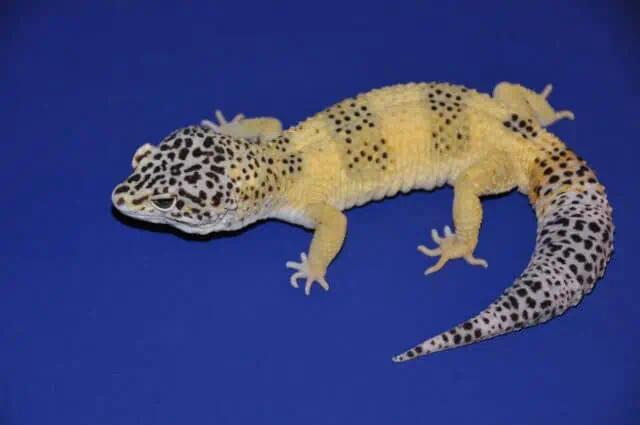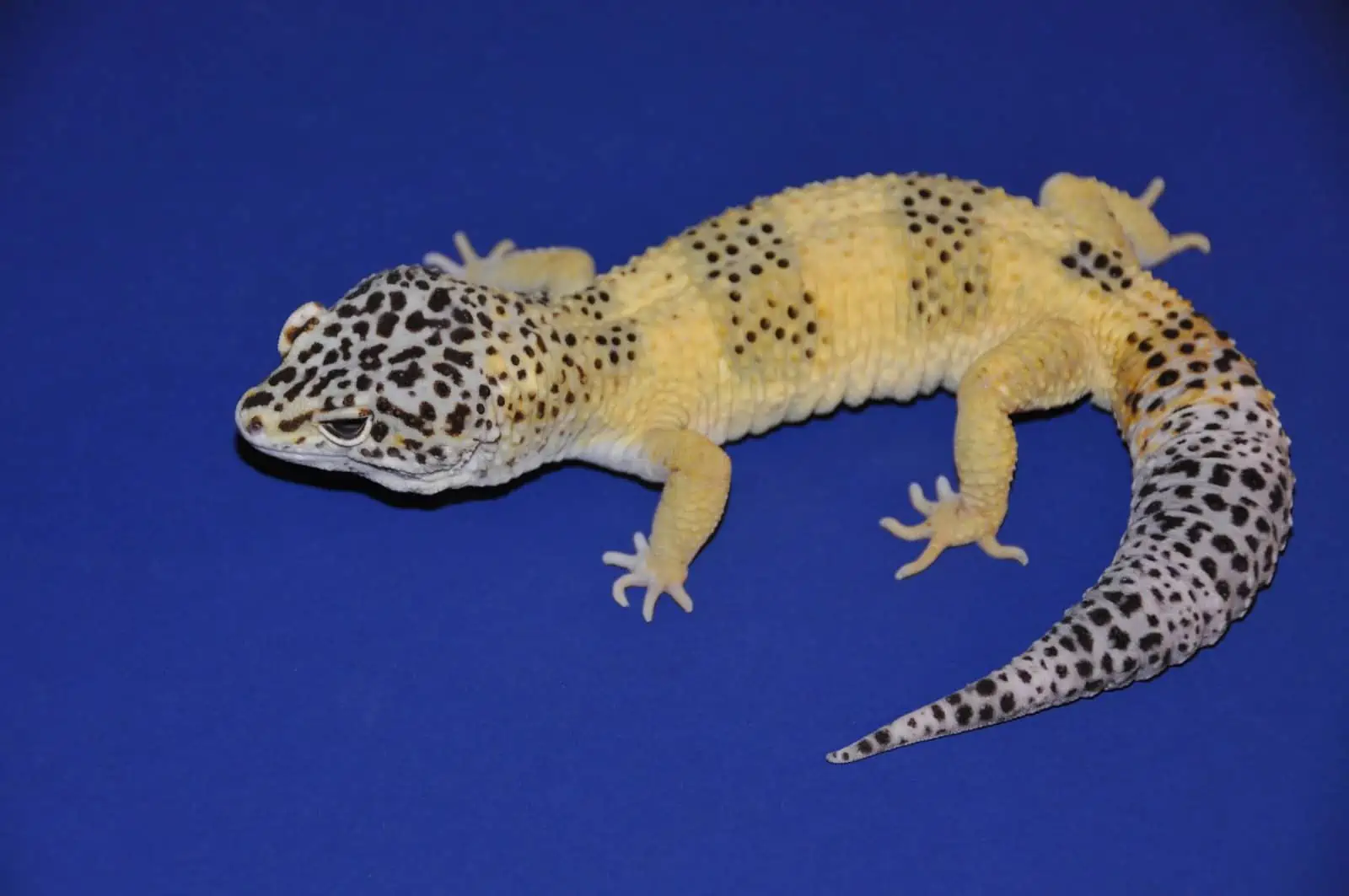The Lemon Frost Leopard Gecko morph is renowned for its striking and vivid coloration, particularly the unique blend of bright yellow and white hues, earning it the “lemon frost” moniker. This morph stands out due to its distinctive appearance, setting it apart from the wild-type leopard geckos, which usually exhibit a more muted color palette and different patterns.
While the beauty of the Lemon Frost morph is undisputed, it’s equally noted for its inherited health issues. This morph has become a focal point in reptile breeding and herpetology circles, sparking discussions and debates around the ethics of breeding animals with known inherited health conditions.
Origin & Appearance: The Lemon Frost Leopard Gecko morph first hatched by Gourmet Rodents in 2012-2013 is known for its unique lemony yellow and frosty white coloration, setting it apart from the earthy tones of wild-type leopard geckos.
Health Concerns: These geckos are predisposed to inherited cancer, manifesting as skin tumors due to over-proliferation of iridophores, a type of skin cell.
Genetic Basis: Research suggests the SPINT1 gene plays a role as a potential tumor suppressor, possibly contributing to the tumor development in this morph.
Ethical Implications: The existence of inherent health issues in this morph has sparked debates on the ethics of breeding, emphasizing the balance between aesthetic breeding and animal well-being.
Research Potential: Given their health vulnerabilities, leopard geckos, especially this morph, are being considered for cancer research, possibly aiding in understanding cancer progression.
History – How It Came To Be

The tale of the Lemon Frost Leopard Gecko morph is as intriguing as its vivid appearance. The origin of this morph can be traced back to the first hatching by a company named Gourmet Rodents between 2012 and 2013. This was the first glimpse into the existence of such a distinctive and radiant morph within leopard geckos, piquing the interest of reptile enthusiasts and breeders alike.
Shortly after, in 2015, Steve Sykes, a well-known figure in the reptile breeding community, acquired some of these Lemon Frost geckos. It was Steve who uncovered a grave concern associated with this morph. He observed the development of tumors on the offspring of Lemon Frost geckos, a discovery that would envelop this morph in a veil of controversy and ethical dilemmas.
The initial charm of the Lemon Frost Leopard Gecko, characterized by its unique coloration, was now overshadowed by the discovery of tumors in its offspring.
Appearance of the Lemon Frost Leopard Gecko
The Lemon Frost Leopard Gecko is a spectacle of nature due to its captivating and distinctive appearance. This morph dazzles with its unique coloration, a radiant blend of lemony yellow and frosty white, standing true to its name, “lemon frost.” This vibrant coloration is complemented by distinctive patterns, rendering it a visual delight in comparison to its wild-type counterparts.
Wild-type leopard geckos typically exhibit more subdued, earthy tones and different patterns. The Lemon Frost morph, with its standout coloration and patterns, breaks this mold, drawing the attention and admiration of reptile enthusiasts and breeders. It’s considered a rare morph of leopard gecko.
Its appearance is not just a deviation but a celebration of nature’s diversity, demonstrating the extensive possibilities within the genetic makeup of leopard geckos. Some are tiny, others are giant, and then there are the ones that stand out visually (such as the Red Stripe Leopard Gecko).
Controversies Surrounding This Leopard Gecko Morph
The Lemon Frost Leopard Gecko morph, despite its dazzling appearance, is enshrouded in controversy primarily due to inherited cancer concerns. The crux of the dispute revolves around the ethical ramifications of breeding an animal known to possess severe health issues.
The inherent risk of skin tumors in this morph has sparked extensive debates within the reptile community, as these tumors are attributed to the over-proliferation of skin cells called iridophores.
Adding another layer to the controversy is the speculation surrounding the genetic basis of this morph. Some suggest the potential presence of a tumor suppressor gene, hinting at a complex genetic architecture intertwined with the vivid coloration of the Lemon Frost.
This possible linkage between aesthetics and health vulnerabilities has fueled ongoing discussions and research endeavors to unravel the genetic intricacies of this morph.
Health: Inherited Cancer
The Lemon Frost Leopard Gecko morph is entwined with a serious and predominant health issue— inherited cancer. This condition significantly overshadows the stunning aesthetics of this morph, raising important ethical questions regarding their breeding. The inherited cancer in these geckos manifests as skin tumors. These tumors arise due to the over-proliferation of specialized skin cells known as iridophores.
Delving deeper into the genetic underpinnings of these tumors, research points to the role of the SPINT1 gene as a potential tumor suppressor. The possible malfunction or alteration of this gene might be contributing to the development of skin tumors in this morph, elucidating a direct connection between their genetic makeup and their susceptibility to cancer.
Moreover, there is a potential risk of these tumors undergoing metastasis, implying they can spread to other parts of the body, exacerbating the health concerns associated with this morph.
This severe health issue has prompted discussions and research into the potential use of leopard geckos as laboratory models for studying cancer. Utilizing them as models can aid in expanding our understanding of cancer development and progression, possibly paving the way for new insights and breakthroughs in cancer research.





